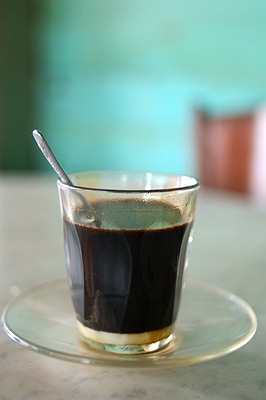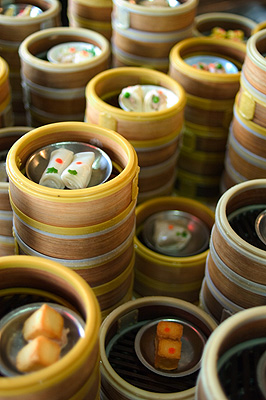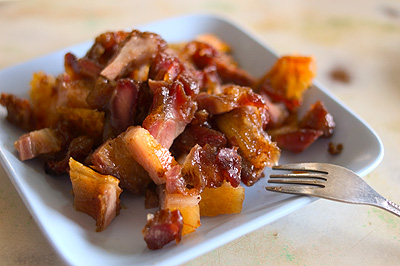ThaiDay, 20/07/06
Southern city solves Thailand's morning blues with its Chinese dim sum breakfast buffets.
Despite the diversity and ubiquity of its cuisine, breakfast in Thailand can often be a dreary sight. The old standby, rice soup, soon becomes tedious after the first couple starchy, stodgy bowls. The omnipresent “American breakfast” consisting typically of oily fried eggs, lighter-than-air white bread, curiously colored hot dogs and undercooked bacon is neither breakfast nor American. And the combination of instant coffee and the oily deep-fried dough known as pa thong ko are enough to send most foreigners running in the other direction. What’s a traveler to do? My suggestion: go to Trang.
Located in southern Thailand, the relatively little-visited city of Trang seems to thrive on breakfast alone. Populated mostly by Thais of Chinese origin, the residents of this city have made early morning eating a true delight with atmospheric cafés that haven’t changed in decades, great halls dedicated to dim sum, and old-fashioned coffee shop-slash-food courts combining both caffeine and food.
“There are at least 70 dim sum shops in Trang city,” estimates Ja, owner of Ruean Thai (075 219 342), one of the city’s best-known dim sum eateries. In his cavernous restaurant located slightly outside downtown Trang, early risers are blessed with a selection of more than 40 steamed dim sum items. “We make all our dim sum by hand,” he explains with evident pride. “Many other places just buy the frozen dim sum and steam it.”
Ruean Thai’s dim sum ranges from quail eggs wrapped in ground pork to plain tofu, and the protocol is much like other dim sum restaurants in the city. After choosing a seat, diners are presented with a large tray of deep-fried dim sum items. You choose what you want, then walk over to the steaming counter where you select your steamed dim sum, which are steamed to order in bamboo trays. Every order is accompanied by a bottomless pot of Chinese tea, and despite the dish’s Chinese origins, chopsticks are nowhere to be seen, the people of Trang favoring tiny forks.
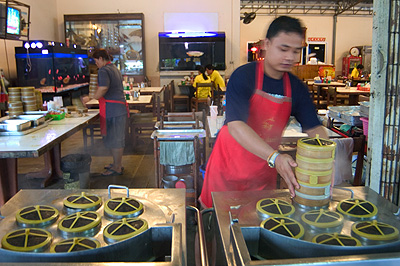
Steaming dim sum at Reuan Thai restaurant, one of the city's best known dim sum eateries.
Along with dim sum, many of Trang’s restaurants also feature another dish not normally associated with breakfast, roast pork. “Before people in Trang didn’t eat roast pork every day,” explains Prasert Namphut, owner of Trang Muu Yaang, a popular restaurant that sells the dish. “Before, it was only for special occasions, or given as an offering on Chinese holidays.”
Nowadays however muu yang, roast pork, is available every day, and in virtually every restaurant. The dish is prepared by marinating an entire pig for eight hours in a mixture of Chinese spices and sauces. “The recipe we use comes from China, it’s an old one that has been used here in Trang for a long time,” explains Prasert. After being marinated, the entire pig is roast for two hours in a giant oven. This relatively short cooking time gives Trang’s roast pork a crispy, nearly charred texture, much unlike the tender, juicy meat that most Americans would associate with barbecued pork.
Every part of the pig is sold, including the head and feet, but the most popular part is undoubtedly the delicious but fatty belly. This cut includes a crispy outer layer of skin, a tender layer of white meat, soft fat and a charred layer of dark meat. The belly is chopped into small bite-sized squares and is served plain along with dim sum, or over rice. Trang Muu Yaang’s roast pork was assertively oily, and the marinade had a sweetness associated with that of American-style barbeque sauce.
Other restaurants featuring similar selections of dim sum and roast pork are the popular Phong Ocha (075 219 918) and Ko Lan (075 222 925). The roast pork at Ko Lan was somewhat spicy, suggesting coriander and cumin, and had little of the barbeque sauce sweetness of its neighbor. However the skin was shatteringly crispy, and overall a bit too fatty to stomach for breakfast. Despite the grease, Trang’s roast pork is so popular that is has become a souvenir, and most shops sell the dish in decorative take-away boxes.
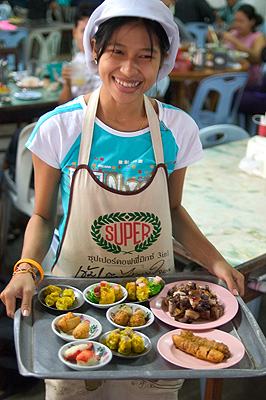
Trang Muu Yang serves dim sum and its popular specialty, roast pork, which is made using an old Chinese recipe.
If all you need in the morning is a simple cup of coffee, then Trang is also well equipped with numerous old-world cafés. Known locally as raan kopi, the shops are almost exclusively owned by Thais of Chinese origin, and many seem suspended in time, sporting the same décor and selling the products they have for decades.
Perhaps the oldest surviving raan kopi, and undoubtedly the most atmospheric, is Yu Chiang, located on Praram 6 Road near the market. Although the owners aren’t exactly sure how old the shop is (one said 60, another 100 years old), it is obvious that the Yu Chiang has changed very little since the day it opened. Faded green paint from the restaurant’s last renovation (50 years ago?) is coupled with ancient marble-top tables and rickety wooden chairs. Adding to the atmosphere is the shop’s clientele of crusty old men of Chinese origin, aged monks, and laborers smoking hand-rolled cigarettes.
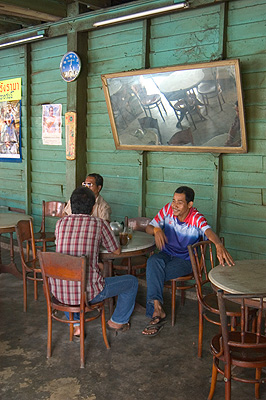
Yu Chiang, a coffee shop in Trang, has changed little since its inception at least 60 years ago.
The coffee at Yu Chiang is still made the old way, using a sock-like filter filled with locally grown and roasted beans, and water from a charcoal-burning stove. The only thing that seems to have changed is the prices. “Coffee used to cost one baht a glass,” explains Yu Chiang’s friendly barista. “That seemed like a lot back then. Now it costs 10 baht, and that’s nothing today!”
For those seeking food with their atmosphere and coffee, there is no better choice than Asia Ocha. Located on Kantang Road, not far from the train station. Asia Ocha is a combination coffee shop and food center of the kind that is still found in Singapore and Malaysia, but hardly exists any more in Thailand. “The shop is no less than 50 years old,” explains Somlak Theekhasenee, the second-generation owner. “You can tell if a coffee shop is really old by looking at the tables. If they’re marble, then the shop is old,” he explains.
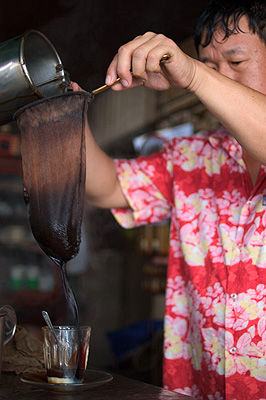
Making coffee the old-fashioned way, Yu Chiang coffee shop.
Asia Ocha’s tables are indeed both marble and old, however Somlak is proud of the shop’s original price list, a stained document stating that, at the time of its printing, coffee cost one baht per cup. He seems oblivious to the fact that his shop is in serious need of a paint job, something doesn’t which doesn’t seem the concern the numerous diners slurping noodles to the sound of Johnny Cash’s “Ring of Fire”.
Other unique coffee shop/restaurants include that of the Koh Teng Hotel (075 218 148), a building dating back to 1948 and located on Rama 6, and Sin Ocha (075 211 191), just steps from Trang’s railway station. The latter offers the usual combination of food and coffee, but without much of the old-world atmosphere. Sin Ocha was originally opened in 1967, but recently underwent a significant renovation and suggests little of its former self. This is made up for by the excellent coffee, which is probably the best in town. Served the traditional way, in short glasses with a dose of sweetened condensed milk, the coffee at Sin Ocha is made in a modern espresso machine, and even features a thin “crema” of foam at the top.
When asked why coffee shops are so popular in Trang, Sin Ocha’s second-generation owner, Sutus Chayankiat, explains that, “In the old days most people in Trang were involved in harvesting rubber. Going to a café after work was a way of exchanging news and info.” Although the people of today’s Trang are involved in a variety of jobs, the city’s raan kopi and dim sum restaurants still largely serve this purpose, and provide a convenient meeting place for locals, and more importantly for us, good coffee and a decent breakfast.












